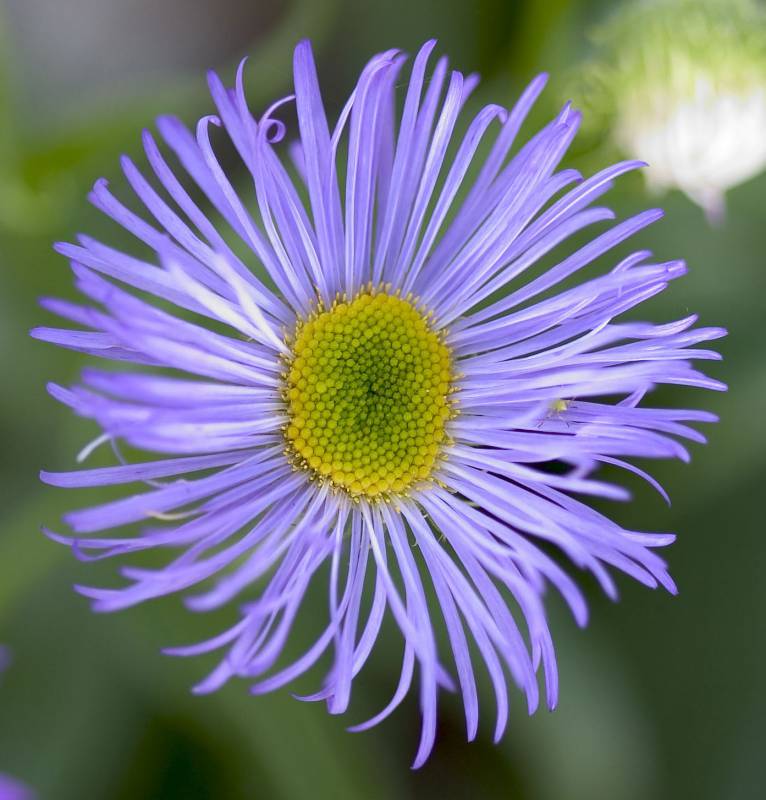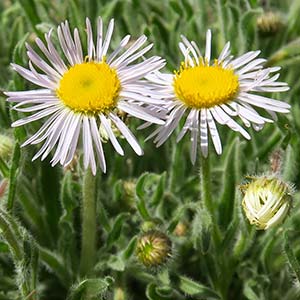|
showy daisy, showy fleabane, splendid fleabane
|
Snake River fleabane, white cushion fleabane
|
| Perennial from a short, woody base, 1.5-8 dm. tall, the stems clustered, amply leafy, glabrous below the inflorescence. |
Perennial from a tap-root, 3-12 cm. high, the stem covered with very unequal, spreading hairs. |
Leaves glabrous, triple-nerved, entire, the lower oblanceolate or spatulate, petiolate, mostly deciduous, the other becoming sessile but ample. |
Leaves nearly all in a basal cluster, finely stiff-hairy, linear or linear-oblanceolate, up to 4 cm. long and 2 mm. wide. |
Heads 1-13 in a open inflorescence; involucre 6-9 mm. high, glandular; rays 65-150, blue or rarely white, 9-18 mm. long and 1 mm. wide; pappus 20-30 bristles, a few of the outer ones shorter. |
Heads solitary; involucres 5-7 mm. high, with spreading short hairs and often glandular as well; rays 30-60, white, pistillate, becoming pinkish, 5-10 mm. long and 1.5-2.3 mm. wide; disk flowers yellow; pappus of 15-25 capillary bristles. |
Achenes 2-nerved. |
|
|
|
|
|
| June-August |
May-July |
| Prairies and forest openings from the lowlands to middle elevations in the mountains. |
Dry, rocky hillsides at low to middle elevations. |
Occurring on both sides of the Cascades crest in Washington; British Columbia to Oregon, Nevada, and Arizona, east to the Rocky Mountains and northern Great Plains.
|
Occurring east of the Cascades crest in the Snake River area in southeastern Washington; southeastern Washington to southeastern Oregon, east to southwestern Idaho.
|
| Native |
Native |
| Not of concern |
Sensitive in Washington (WANHP) |
E. acris, E. aliceae, E. annuus, E. aureus, E. basalticus, E. bloomeri, E. caespitosus, E. chrysopsidis, E. compositus, E. corymbosus, E. davisii, E. disparipilus, E. divergens, E. eatonii, E. elatus, E. filifolius, E. flettii, E. glacialis, E. howellii, E. inornatus, E. karvinskianus, E. leibergii, E. linearis, E. lonchophyllus, E. nivalis, E. oreganus, E. peregrinus, E. philadelphicus, E. piperianus, E. poliospermus, E. pumilus, E. salishii, E. strigosus, E. subtrinervis |
E. acris, E. aliceae, E. annuus, E. aureus, E. basalticus, E. bloomeri, E. caespitosus, E. chrysopsidis, E. compositus, E. corymbosus, E. davisii, E. divergens, E. eatonii, E. elatus, E. filifolius, E. flettii, E. glacialis, E. howellii, E. inornatus, E. karvinskianus, E. leibergii, E. linearis, E. lonchophyllus, E. nivalis, E. oreganus, E. peregrinus, E. philadelphicus, E. piperianus, E. poliospermus, E. pumilus, E. salishii, E. speciosus, E. strigosus, E. subtrinervis |
| |



